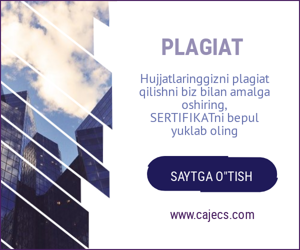DIAGNOSTICS BASED ON BLOOD ANALYSIS INDICATORS USING THE ADABOOST ALGORITHM
Keywords:
blood analysis, AdaBoost algorithm, machine learning, classification, bioanalyze, medical dataset, ensemble learning, methods, specificity, diagnosticsAbstract
This article discusses the use of the AdaBoost algorithm for disease diagnosis based on blood parameters. The study analyzes how the algorithm adapts to various datasets consisting of blood parameters and identifies key biomarkers that affect the accuracy of diagnosis. It is shown that the use of this algorithm allows for increased pathology recognition efficiency compared to traditional methods, providing higher sensitivity and specificity. The abstract also includes a comparative analysis of AdaBoost performance with other machine learning models, highlighting its advantages in the field of diagnostics based on medical data. A systematic approach to the medical diagnosis process, methods, models and algorithms for making diagnostic solutions have been developed. The developed model and algorithms make it possible to create a system that uses the adoption of a hybrid intelligent diagnostic solution. A multivariate probabilistic model was created taking into account the weighting coefficient of experts and the mutual compatibility of experts' assessments. This allows to make a collegial diagnostic solution with a certain probability that the patient has the suspected disease. A generalized logical model of the multi-stage reasoning process of experts on diagnosis was created.
References
Freund, Y., & Schapire, R. E. (1997). A decision-theoretical generalization of on-line learning and an application to boosting. Journal of Computer and System Sciences, 55(1), 119–139. DOI: 10.1006/jcss.1997.1504.
Jones, M., Smith, A., & Brown, R. (2020). Application of AdaBoost for diabetes diagnosis based on blood test results. Journal of Medical Informatics, 35(2), 245–252.
Lee, K., & Huan, Z. (2021). Ensemble learning approaches for early detection of cardiovascular diseases using blood sample data. Computational Biology and Medicine, 134, 104461. DOI: 10.1016/j.compbiomed.2021.104461
Breiman, L. (2001). Random forests. Machine Learning, 45(1), 5–32. DOI: 10.1023/A:1010933404324
Hastie, T., Tibshirani, R., & Friedman, J. (2009). The Elements of Statistical Learning: Data Mining, Inference, and Prediction. Springer.
Elkan, C. (2001). The foundations of cost-sensitive learning. In Proceedings of the 17th International Joint Conference on Artificial Intelligence (IJCAI), 973–978.
Kotsiantis, S. B., Zaharakis, I., & Pintelas, P. (2007). Supervised machine learning: A review of classification techniques. Informatica, 31(3), 249–268.
Chen, X., & Guestrin, C. (2016). XGBoost: A scalable tree boosting system. In Proceedings of the 22nd ACM SIGKDD International Conference on Knowledge Discovery and Data Mining, 785–794. DOI: 10.1145/2939672.2939785.
Quinlan, J. R. (1996). Bagging, boosting, and C4.5. In Proceedings of the National Conference on Artificial Intelligence, 725–730.
Q.Bekmuratov, S.Olimjonova “Проблематика формирования процесса автоматизации управления данными менеджмента информационной безопасности” mavzusida Eurasian journal of mathematical theory and computer sciences Innovative Academy Research Support Center UIF = 8.3 | SJIF = 5.916 www.in-academy.uz
S.Olimjonova “Tibbiyot sohasidagi masalalarga sun’iy intelekt yordamida
yechim.” mavzusida “Zamonaviy axborot, kommunikatsiya texnologiyalari va AT- ta’lim tatbiqi muammolari” mavzusidagi respublika ilmiy-amaliy anjumani 9-aprel 2022-yil, Samarqand, 143-144 betlar.
S.Olimjonova, X.Shamsiyeva “Avtomatlashtirilgan tizimlarda tanib olish algoritmlarini qo‘llash” "Science and innovation", https://t.me/science_innovations 193-207 betlar.
S.Olimjonova “Выбор аппаратного и программного обеспечения для автоматизации библиотеки” mavzusida "Development and innovation" Scientific online journal https://doi.org/10.528/zenodo.6947572 392-397 betlar
Downloads
Published
How to Cite
Issue
Section
License
Copyright (c) 2024 Olimjonova Saodat G'ulomjon qizi

This work is licensed under a Creative Commons Attribution 4.0 International License.












